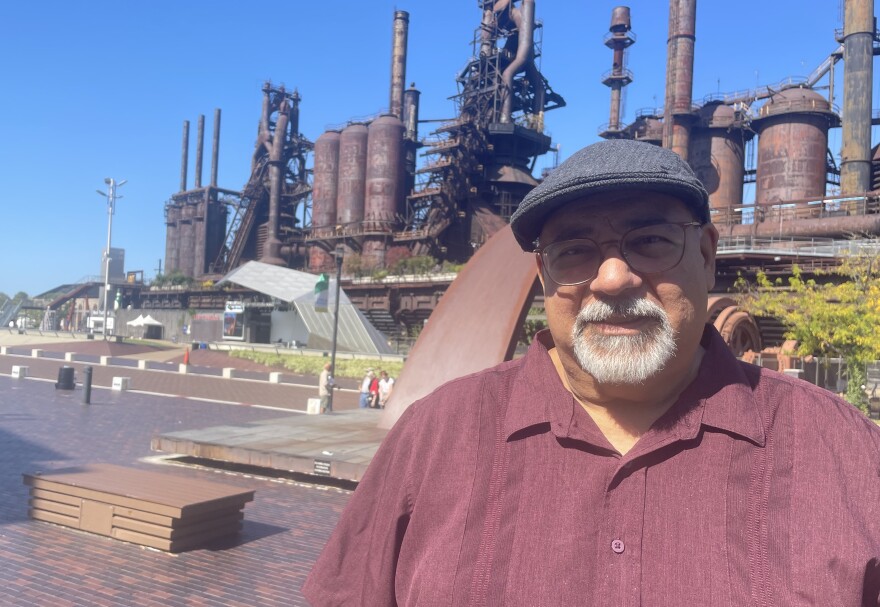EDITOR'S NOTE: This is one in a recurring series: Lehigh Valley 250th — a project that examines our region's place and contributions in American history leading up to the nation's 250th anniversary next year.
BETHLEHEM, Pa. — Thirty years after the Bethlehem Steel stacks and mill fell silent forever, Bob Donchez worries.
The 75-year-old former Bethlehem city councilman and mayor squints a look of concern gazing at the rusted stacks set against an azure sky.
Donchez fears the impact of Bethlehem Steel, which at its peak employed 31,000 in the Lehigh Valley and was the 14th-largest corporation in America, may be forgotten.
He fears that the impact of the company, which was the roaring economic engine of the Lehigh Valley for more than a century, will be forgotten.
He fears its lofty place here and nationally during America’s industrial revolution might fade into the mists of time.
“As the old-timers pass away, I worry people will forget about the importance and significance Bethlehem Steel played here and throughout the United States and through the war effort,” Donchez said.
As the Lehigh Valley joins America in celebrating the nation’s 250th birthday in 2026, those who remember say it is imperative that current and future generations know of Bethlehem Steel’s vital role locally and nationally.
More than 100 years since they were built, the blast furnaces of Bethlehem Steel tell a multi-layered story.
"People can never forget what Bethlehem Steel did."Bob Donchez, former Bethlehem city councilman and mayor
Among them are it becoming the towering centerpiece for one of the nation’s largest and most successful brownfields redevelopment projects — consisting of Lehigh Valley Industrial Park VII, the Majestic Bethlehem Center, Wind Creek Bethlehem casino, the SteelStacks campus and more.
“I was on the city council when the steel plant closed (in 1995) and left a void,” Donchez said.
“When you look at Pennsylvania, many times when steel companies closed, the towns didn’t come back. When you lose your largest employer, water user and taxpayer, to come back as we have today, that’s a credit to a lot of people.”
A comeback story
Bethlehem was fortunate, Donchez said, to have bipartisan leadership to navigate the uncertain waters of post-steel.
“There was great leadership with the Lehigh Valley Industrial Park and the Chamber,” he said. “Bethlehem has two industrial parks — LVIP I on the west side by the airport, and LVIP VII on the old Bethlehem Steel property. We employ 8,000 people there.
“We were able to put it together and the valley was able to come back.”
Also to be remembered as one gazes at the rusted stacks was the blending of thousands of immigrants — Hungarians, Italians, Poles, Latinos and Slovaks — who worked together to create steel and a better life for themselves and their families.
That mix of cultures — none wanting to be outworked by the others — rivaled the mix of iron ore, coal and scrap steel in importance in building the region and the nation.
That is not an overstatement.
What was built with Bethlehem Steel? The Golden Gate Bridge, Empire State Building, George Washington Bridge, Rockefeller Center, Madison Square Garden, Hoover Dam, Chrysler Building, Ben Franklin Bridge and Alcatraz prison, to name a few.
Also, 1,100 war ships during World War II, and vast quantities of armor, guns, shells and other munitions during World War I and II.
“People can never forget what Bethlehem Steel did,” Donchez said.
The history and legacy of Bethlehem Steel is complicated, what with the company’s reluctance to modernize and innovate, and examples of greed by management and the unions playing a role in the company’s demise.
Yet, 30 years after the last steel beam was cast, the Steel's imprint on the region and its people remains unmistakable.
All in the family
Don Cunningham remembers.
At its peak in the 1950s, Bethlehem Steel employed tens of thousands across a five-mile stretch of steelmaking facilities in the city.
Among them was Cunningham’s father, Don, and before him his grandfather and great-grandfather.
“That’s all I knew growing up — the steel mill."Don Cunningham, CEO of Lehigh Valley Economic Development Corp. and a former Bethlehem mayor
And had the former Bethlehem mayor and current president and CEO of the Lehigh Valley Economic Development Corp. had his way, he would have followed in their bootsteps.
“That’s all I knew growing up — the steel mill,” Cunningham said. “I just thought I was going to work at the mill. And my dad was like, ‘I don’t want you to do this.’ He wanted better for me and my sister. He wanted us to go to college. He was insistent about it.
“So we went to college. You didn’t fight him about it.”
Cunningham Sr. is retired in South Florida. Proud of having built a life because of the steel mill. Prouder still that steel afforded his children — as it did many other steelworkers — the chance for a better, less-backbreaking life.
“I watched my dad’s eyes one time talking about the benefits of having worked at the mill,” Cunningham said. “He was able to buy a little ranch house in Bethlehem Township and send his kids to college. He was grateful and proud. I’ll never forget that look. All that he had, he credited to the steel mill.”

Hard work, difficult conditions
Guillermo Lopez remembers.
The former steelworker estimates that his family, including those of his wife, worked 300 combined years at Bethlehem Steel.
“Even my wife worked there for three years,” said Lopez, 70.
Lopez himself spent 27 years as a millwright, a highly skilled mechanic on complex industrial machinery and equipment.
A first-generation American of Puerto Rican descent, Lopez shares the good and the bad of his time with the company.
If not for greed and arrogance on the part of management, Bethlehem Steel may have lived on, Lopez said.
“I’m not a historian,” he said. “But it appears to me that the arrogance of the steel industry put itself out of business.
“There was an inability to recognize that some people were smarter than they were. They were protesting, the union and the company, against foreign steel because it was making less money for them. All parts of the world were making steel for less.
“The companies that put us out of business were making it smarter. The mini mills were smart enough to use scrap steel.”
Lopez compared Bethlehem Steel management to the taxi industry that underestimated the competition.
“The taxi companies filed lawsuits to try to stop them,” he said. “Eventually, they learned, somebody built a better mousetrap. Arrogance put steel out of business.”
Lopez believes the poor working conditions at the plant were the cause of many of his coworkers to endure health issues.
He believes a designated "clear air" lunchroom would have been a significant improvement to industrial working conditions at Bethlehem Steel, where workers were otherwise exposed to a century of severe air pollution.
“The work itself was horrendous,” he said. “I remember sitting in the lunch room. It would’ve been nice to have a clear air room. “Everybody suffered from health issues.”
Among them was Lopez’s father, a 36-year worker who died from kidney disease.
“I’m at that stage now with my kidneys,” he said. “I’m on the (transplant waiting) list.”
'What now?'
Jerry Green remembers.
The recently retired and longest-serving president of Bethlehem’s United Steelworkers’ Union, Local 2599, began working at the steel mill in 1973 at age 18.
There was a sense of pride not only among workers, Green said, but throughout the community when it was learned someone worked at Bethlehem Steel.
“It had such a major impact on the Lehigh Valley,” said Green, 70, who worked there until 1998 in various capacities.
“Years before me, and then during when I worked there, you’d walk into a bank and tell them you were employed by Bethlehem Steel. They’d put out the red carpet for you. It was like that for many years.”
When the steel mill closed, the fear that permeated the Lehigh Valley was tangible: What now?
“People thought maybe it would turn into a ho-hum area,” Green said. “Remember, Bethlehem Steel was the second-largest steelmaker in the world.
“But there were and are people here who I credit for keeping the local economy going, with the industrial parks and the casino. People like Don Cunningham, Bob Donchez, Lisa Boscola and Charlie Dent. They brought those jobs and big revenue.”
Memories live on
Donchez, Cunningham, Lopez and Green.
Each remains incredibly appreciative of when Bethlehem Steel was king in the Lehigh Valley. Respect bordering on reverence of how it impacted their lives and those of so many. How they continue holding those memories dear in their hearts and minds.
And as they remember, their request to today’s generation and beyond is simply this:
Never forget.
CHECK IT OUT: The National Museum of Industrial History, 602 E. Second St. in Bethlehem, will host Steel Weekend Oct. 11-12 at the museum and on the SteelStacks campus. Admission is free. Events include live demonstrations, a steelworkers' reunion, guest speakers and a hot iron pour. At 3:30 p.m. Friday, Lehigh Valley Public Media will host a free screening of the PBS39-produced "Bethlehem Steel: The People Who Built America," at the Univest Public Media Center on the SteelStacks campus. It will include reflections from Andria Zaia of the National Museum of Industrial History and Bette Kovach, a retired Bethlehem Steel spokesperson. Register for a free ticket here.

















